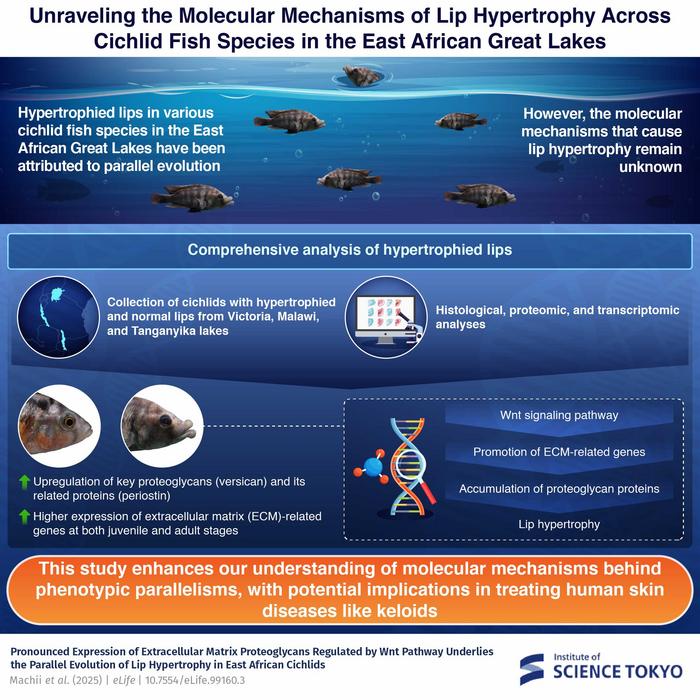A groundbreaking study from the Institute of Science Tokyo, published in eLife on April 22, 2025, sheds new light on the molecular underpinnings of lip hypertrophy in cichlid fishes from the East African Great Lakes. This research uncovers a crucial role for the extracellular matrix (ECM) proteoglycans regulated by the Wnt signaling pathway, revealing a shared molecular framework driving the parallel evolution of enlarged lips in these remarkable fishes. The implications of this work extend beyond evolutionary biology, potentially informing our understanding of human skin disorders.
Cichlids represent one of the most diverse families of freshwater fish, renowned for their rapid evolutionary adaptations and distinctive morphological traits, including varied snout and jaw architectures. Among these features, hypertrophied lips have independently evolved within cichlid populations inhabiting Lakes Victoria, Malawi, and Tanganyika. These enlarged lips confer functional advantages, enhancing the detection and capture of prey by increasing the surface area for taste receptors, a classic example of adaptive parallel evolution.
Despite extensive research on cichlid morphology and ecology, the molecular mechanisms orchestrating lip hypertrophy have remained elusive. Addressing this gap, the collaborative effort led by Associate Professor Masato Nikaido from Institute of Science Tokyo, working alongside researchers from Tanzania Fisheries Research Institute, employed an integrative omics and histological approach to dissect the genetic and molecular basis of this phenotype across geographically distinct cichlid lineages.
The researchers began by performing comparative histological analyses on lip tissues of hypertrophied and normal-lipped cichlids from all three lakes. They consistently observed a pronounced thickening of the proteoglycan-rich layer within the ECM of hypertrophied lips. Proteoglycans, known for providing structural support and regulating cellular functions, appeared to be central players in the lip hypertrophy phenotype, indicating that ECM remodeling is integral to morphological adaptation in these fishes.
Utilizing proteomics, the team identified a set of 133 proteins significantly upregulated in hypertrophied lips, contrasted with a mere five proteins downregulated. Among the former, proteoglycans such as versican and periostin were highly abundant, especially concentrated at the lip tips. These proteins are recognized for their roles in ECM organization and cellular signaling, suggesting an active remodeling process underpinning lip enlargement.
To elucidate the gene expression networks involved, transcriptome analyses were conducted across developmental stages of cichlids exhibiting hypertrophied and normal lips. The data unveiled a strikingly consistent upregulation of genes associated with the Wnt signaling pathway, a key regulator of cellular proliferation, differentiation, and tissue patterning. This pathway’s activation in both juvenile and adult stages underscores its sustained influence on lip development and maintenance.
Remarkably, despite the genetic divergence among cichlid populations in the three lakes, the expression patterns of ECM-related genes showed convergence in hypertrophied individuals. This finding highlights the parallel molecular evolution of lip hypertrophy, driven by similar regulatory pathways convergently acting in geographically and genetically distinct lineages. Such a shared molecular signature reinforces the concept of evolutionary predictability in complex traits.
The study’s novel focus on ECM components links evolutionary adaptations in cichlids with pathological processes observed in humans. Versican and periostin, the proteoglycans implicated here, are also central to fibrotic skin diseases such as keloids, where excessive ECM deposition leads to abnormal tissue thickening. Thus, this research offers a unique comparative perspective, suggesting that mechanisms co-opted during evolution may overlap with those involved in human disease.
Functionally, the hypertrophied lips serve as enhanced sensory structures facilitating benthic foraging. By expanding the proteoglycan-rich ECM layer, cichlids maximize the surface area housing taste receptor cells, allowing more effective detection of prey hidden within substrates. This adaptation likely confers significant ecological advantages, contributing to the species’ evolutionary success in diverse lacustrine environments.
From a methodological standpoint, the multidisciplinary approach adopted in this research—integrating histology, proteomics, and transcriptomics—exemplifies cutting-edge strategies to unravel complex phenotypes. By correlating molecular data with morphological and ecological observations, the team provides a comprehensive view of the mechanisms driving adaptive traits, a model applicable to other evolutionary studies.
This investigation not only enriches understanding of cichlid biology but also opens avenues for biomedical research. Insights into ECM regulation by Wnt signaling may inform therapeutic strategies for human fibrotic conditions, highlighting the translational potential of evolutionary developmental biology. Future studies may exploit this knowledge to develop interventions targeting ECM dynamics in skin diseases.
In summary, the compelling evidence presented by the Institute of Science Tokyo and their Tanzanian collaborators reveals a conserved molecular toolkit mediating the parallel evolution of lip hypertrophy in East African cichlids. The interplay of ECM proteoglycans and Wnt pathway activity emerges as a critical determinant of this adaptive phenotype, bridging evolutionary biology and medical science in groundbreaking ways.
Subject of Research: Animals
Article Title: Pronounced expression of extracellular matrix proteoglycans regulated by Wnt pathway underlies the parallel evolution of lip hypertrophy in East African cichlids
News Publication Date: 22-Apr-2025
Web References:
https://doi.org/10.7554/eLife.99160.3
Image Credits:
Institute of Science Tokyo, Japan
Keywords:
Organismal biology, Fisheries, Ecology, Aquatic ecology, Aquatic ecosystems, Marine ecology




